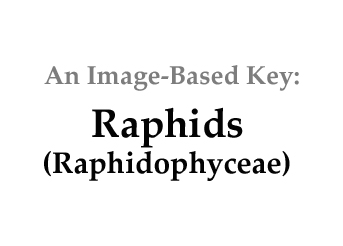


The Raphidophyceae are biflagellate “heterokonts” (two different
types of flagella), with one thinner, smooth trailing flagellum, and a
thicker leading flagellum with mastigonemes. Defensive organelles called "extrusosomes" (or
"trichocysts" although they are organelles, not cells) line the
naked cell membrane (no cell wall is present).
Sexual as well as asexual reproduction is known in Gonyostemum semen (Figueroa and Rengefors 2006)..
Earlier called “chloromonads” by Krebs, they were renamed by Bourelly (1970) to avoid confusion with chlorophycean genus Chloromonas (Pentecost 2002). Freshwater genera have photoreceptive pigments similar to the Tribophyceae, while marine genera are similar to the Chrysophyceae. However, 18S RNA nucleotide sequence analysis indicates that all raphid genera are monophyletic and distinct as a class (Potter et al. 1997).
Toxic marine blooms of Chattonella
verruculosa in the Delaware Inland Bays caused "massive
mortality" of marine life in 2000 (Hutchins et al. 2006).
Freshwater genera frequently found in acidic lakes and bogs are Gonyostomum (most common), Merotricha, and Vacuolaria. Marine genera include Chattonella, Fibrocapsa, Heterosigma, Haramonas, and Olisthodiscus (Graham and Wilcox 2000).
An excellent comparison of the green line and golden-brown line of raphids created by Carmelo Tomas can be found online. The heterotrophic genus Actinosphaerium has been placed in this class Raphidophyceae by Cavalier-Smith 2013.
Click on images for larger format
References:
Bourrely, P. 1970. Les Algues d’Eau Douce I. Les Algues III. Les Algues Bleues et Rouges; Les Eugléniens, Peridiniens et Cryptomonadines. Boubée, Paris. 512 pp.
Figueroa, R.I., and K. Rengefors 2006. Life cycle and sexuality of the freshwater raphidophyte Gonyostomum semen (Raphidophyceae). Journal of Phycology 42:859-871..
Graham, L.E.., and L.W. Wilcox 2000. Algae. Prentice Hall, Upper Saddle River, NJ (pp. 270-272).
Hutchins, D.A., C.S. Craig, K.J. Coyne, and M.
Doglin 2006. Final Report: Investigation of toxic Raphidophyte population
dynamics using molecular and physiological tools. Online:
Pentecost, A. 2002. Phylum Raphidophyta. In: The freshwater algal flora of the British Isles. Cambridge Press (pp. 208-213).
Potter, D., G.W. Saunders, and R.A. Andersen 1997. Phylogenetic relationships of the Raphidophyceae and Xanthophyceae as inferred from nucleotide sequences of the 18S ribosomal RNA gene. American J. Bot. 84:966-972.




